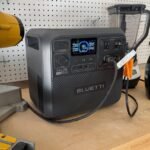Disclosure: This post contains affiliate links and I will be compensated if you make a purchase after clicking through my links. Learn More
To test an AVR on a generator, measure the output voltage and check for voltage stability. Use a multimeter for accurate readings.
Testing the Automatic Voltage Regulator (AVR) on your generator ensures reliable performance and optimal power output. The AVR regulates the voltage to protect sensitive electrical equipment from fluctuations. A malfunctioning AVR can lead to inconsistent power supply, damaging both the generator and connected devices.
Begin by inspecting the generator visually for any obvious signs of wear or damage. Verify that all connections are secure. Use a multimeter to measure the output voltage, ensuring it falls within the specified range. Regular maintenance and testing of the AVR will prolong the lifespan of your generator and ensure it operates efficiently.

Introduction To AVR Testing
Testing the Automatic Voltage Regulator (AVR) on your generator ensures it works well. The AVR maintains a steady voltage output, protecting your devices. Regular testing of the AVR helps identify potential problems early. This guide will help you understand the basics of AVR testing.
Importance Of AVR
The AVR is crucial for generator performance. It keeps the voltage stable, protecting connected devices. Voltage fluctuations can damage sensitive electronics. A working AVR prevents this, ensuring safety and efficiency. Regular AVR testing safeguards your equipment.
Common AVR Issues
AVRs can face several issues. Here are the common ones:
- Voltage Fluctuations: The output voltage may vary unexpectedly.
- Overheating: AVRs can overheat under heavy load.
- Component Failure: Internal parts may fail over time.
- Corrosion: Moisture can cause corrosion inside the AVR.
Understanding these issues helps in timely maintenance. Regular checks can prevent major failures.
Basic Avr Testing Steps
- Turn off the generator and disconnect it from all loads.
- Inspect the AVR for visible damage or wear.
- Use a multimeter to measure the output voltage.
- Compare the readings with the manufacturer’s specifications.
- If readings are off, consider professional inspection.
Follow these steps for a basic AVR check. Ensure safety and accuracy during testing.
Required Tools And Equipment
Testing the Automatic Voltage Regulator (AVR) on a generator requires specific tools and equipment. Having the right instruments and gear ensures accuracy and safety. This section details the essential tools and safety gear needed for AVR testing.
Essential Instruments
- Multimeter: Measures voltage, current, and resistance accurately.
- Oscilloscope: Visualizes electrical signals to detect anomalies.
- Load Bank: Simulates generator load for testing purposes.
- Frequency Meter: Monitors the generator’s frequency output.
- Insulation Tester: Checks the insulation resistance of generator windings.
Safety Gear
- Insulated Gloves: Protects hands from electrical shock.
- Safety Goggles: Shields eyes from sparks and debris.
- Ear Protection: Reduces noise from the generator.
- Fire Extinguisher: Essential in case of electrical fires.
- First Aid Kit: Handy for minor injuries during testing.
Preparing The Generator
Before testing the AVR on your generator, proper preparation is crucial. This ensures your safety and the accuracy of the test. Follow these steps to get started on the right foot.
Initial Inspection
Begin with a visual inspection of the generator. Look for any visible damage or loose connections.
- Check for frayed wires or exposed components.
- Ensure the generator is clean and free of debris.
- Verify that all screws and bolts are secure.
Inspect the fuel level and oil levels. Ensure they are at the recommended levels. This will prevent any mishaps during the testing process.
Disconnecting The AVR
Locate the Automatic Voltage Regulator (AVR) on your generator. It is usually near the control panel.
- Turn off the generator and disconnect it from any power source.
- Use a screwdriver to remove the cover protecting the AVR.
- Carefully disconnect the wires connected to the AVR terminals.
Label each wire to remember their proper connections later. This will simplify the reassembly process after testing.
Store the screws and cover in a safe place. You will need them to reassemble the generator.
Testing Procedures
Testing the Automatic Voltage Regulator (AVR) on a generator is crucial. It ensures the generator works properly. This section covers the essential testing procedures.
Visual Inspection
Start with a visual inspection. Look for any obvious damage. Check for burnt components or loose wires. Ensure all connections are tight. Inspect the AVR for any visible signs of wear.
Using A Multimeter
Next, use a multimeter to test the AVR. Set the multimeter to the appropriate setting. Follow these steps:
- Set the multimeter to measure resistance.
- Connect the multimeter probes to the AVR terminals.
- Check the resistance values against the manufacturer’s specifications.
If the resistance is out of range, the AVR may be faulty. Check the voltage output as well. Set the multimeter to measure AC voltage. Connect the probes to the generator’s output terminals. Ensure the voltage matches the generator’s rating.
| Test | Multimeter Setting | Expected Value |
|---|---|---|
| Resistance | Ohms | Check Manufacturer’s Specs |
| Voltage Output | AC Voltage | Match Generator’s Rating |
These steps help ensure your generator’s AVR is functioning correctly.
Interpreting Test Results
Understanding how to interpret test results is crucial for maintaining your generator’s Automatic Voltage Regulator (AVR). Accurate interpretation ensures your generator functions efficiently and safely.
Voltage Readings
To assess the AVR, start by checking the voltage readings. Use a multimeter to measure the output voltage.
- Normal Voltage: Typically, the voltage should be around 230V for single-phase or 400V for three-phase systems.
- Low Voltage: If readings are below these values, it indicates a potential AVR issue.
- High Voltage: Readings above the normal range also suggest AVR malfunction.
| Voltage Range | Interpretation |
|---|---|
| 230V (Single-phase) / 400V (Three-phase) | Normal Operation |
| Below 230V / 400V | Possible AVR Problem |
| Above 230V / 400V | Potential AVR Issue |
Common Fault Indicators
Identifying common fault indicators helps in diagnosing AVR issues.
- Flickering Lights: This suggests unstable voltage output.
- Generator Overheating: Could be due to AVR malfunction.
- Unusual Noises: Indicates potential internal AVR problems.
Regularly testing your generator’s AVR ensures its longevity. It also ensures your electrical devices remain safe.
Troubleshooting Common Issues
Testing an AVR on a generator requires careful attention. Common issues can disrupt the generator’s performance. This section dives into frequent problems and solutions.
Low Voltage Output
Low voltage output is a common issue. First, check the generator’s connections. Loose or corroded connections can cause voltage drops. Ensure all wires are tight and clean.
Next, inspect the AVR settings. Incorrect settings lead to low voltage. Refer to the manufacturer’s manual for correct values. Adjust the settings as needed.
Check the generator’s load. Too much load can reduce voltage. Use a load tester to measure the load. Ensure it is within the generator’s capacity.
Here is a quick checklist for low voltage output:
- Check connections
- Inspect AVR settings
- Measure the load
Erratic Performance
Erratic performance can cause serious issues. Start by checking the fuel supply. Ensure there is enough fuel. Also, check for fuel contaminants. Clean fuel lines and replace old fuel.
Next, examine the generator’s air filter. A dirty air filter restricts airflow. This leads to erratic performance. Clean or replace the air filter regularly.
Inspect the spark plugs. Worn or dirty spark plugs cause misfires. Replace spark plugs if they show signs of wear.
Below is a table for troubleshooting erratic performance:
| Component | Issue | Solution |
|---|---|---|
| Fuel Supply | Low or contaminated fuel | Refill and clean fuel lines |
| Air Filter | Dirty filter | Clean or replace filter |
| Spark Plugs | Worn or dirty plugs | Replace spark plugs |
Maintenance Tips
Proper maintenance of your generator’s Automatic Voltage Regulator (AVR) is crucial. Regular care ensures optimal performance and longevity. Follow these essential maintenance tips to keep your generator in top shape.
Regular Inspection
Regular inspection of the AVR is vital. Check for any visible damage or wear. Look for loose connections or corroded parts. Use a multimeter to measure voltage output. This ensures the AVR is functioning correctly. Schedule these inspections monthly.
Cleaning And Storage
Cleaning the AVR is essential. Dust and debris can affect performance. Use a soft brush or compressed air to clean the unit. Ensure no moisture enters the AVR.
Proper storage is also crucial. Store the generator in a dry, cool place. Avoid areas with extreme temperatures. Cover the generator to protect from dust and dirt. This prolongs the life of the AVR and the generator.
When To Seek Professional Help
Testing the AVR on a generator can be tricky. Some tasks are better left to experts. Here are times when you should call a professional.
Identifying Complex Problems
Some AVR issues are simple. Others are complex and need expert help. Complex problems might show odd signs. For example, the generator might run but not produce power.
Another sign is erratic voltage output. If the voltage jumps up and down, it is a complex issue. These problems often need special tools and skills.
Don’t try to fix these issues on your own. You might make the problem worse. It’s best to hire a technician.
Choosing A Qualified Technician
Hiring the right technician is crucial. Look for someone with experience in AVRs. Not all technicians are equal. Here are some tips to find a good one:
- Check their certifications.
- Read reviews from other clients.
- Ask about their experience with AVRs.
A good technician will also have the right tools. They should be able to explain the problem. They should also offer a clear solution.
When you find a good technician, keep their contact info. You might need their help again.
Read Here: How to bypass generator AVR

Frequently Asked Questions
What Is An AVR On A Generator?
The AVR (Automatic Voltage Regulator) is like your generator’s traffic cop. It controls power output to keep it steady and safe for your appliances. Without it, power levels might jump up and down.
Why Test An AVR On A Generator?
Testing your AVR helps catch problems early. A bad AVR can send wrong power levels to your devices and might break them. Think of it like checking your car’s oil to prevent engine damage.
How Do You Test An AVR On A Generator?
Use a voltage meter to check power levels while the generator runs. This tells you if the AVR is working right. Always check your owner’s manual first – it’s your best guide.
What Tools Are Needed To Test An AVR?
You’ll need three main things: a voltage meter to test power, thick rubber gloves to keep safe, and safety glasses to protect your eyes. Safety first – electricity is no joke!
Final Words
Testing the AVR on your generator ensures its optimal performance. Follow the steps outlined to maintain reliability. Regular checks can prevent unexpected failures. Keep your generator in top condition for all your power needs. Proper maintenance extends the lifespan of your equipment.
Enjoy uninterrupted power with a well-functioning AVR.








